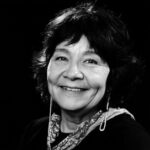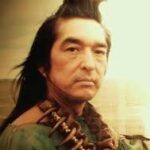Angak, Hopi rain kachina
Ahöla Kachina, also known as Ahul, opens the mid-winter Powamu ceremony
The Ahöla Kachina, also known as Ahul, is a spirit being, embodied by a man, in Hopi religion.
Ahöla is one of the important chief katsinam for First and Second Mesas because he opens the mid-winter Powamu ceremony, sometimes called the Bean Planting Festival, officially beginning Katsina season. Ahöla Kachina, also known as Ahul, opens the mid-winter Powamu ceremony »»
Leslie Marmon Silko: A Native American Writer of Distinction

Leslie Marmon Silko is a Laguna Pueblo Native American writer who is best known for her novels, short stories, and poetry. She is one of the most important figures in Native American literature, and her work has been praised for its lyrical beauty, its complex exploration of Native American culture and history, and its political activism. Leslie Marmon Silko: A Native American Writer of Distinction »»
Sinixt or Lake Indians are now part of the Confederated Tribes of the Colville Reservation
Today the Sinixt, or Lake Indians, as they are also known, live primarily on the Colville Indian Reservation in Washington State, where they form part of the Sinixt, or Lake Indians, which is recognized by the United States government as an American Indian Tribe.
A few Sinixt live in their traditional West Kootenay territory, particularly the Slocan Valley. They are no longer legally recognized by the Canadian government.
Most Sinixt or Lake indians are now part of the Colville tribe in Washington state, but once roamed both Washington and British Columbia, Canada.
In Canada, this tribe has been ‘officially’ declared distinct. They are now one of the twelve bands or tribes that make up the federally recognized Confederated Tribes of the Colville Reservation, and are fighting to reclaim their traditional status in Canada. Sinixt or Lake Indians are now part of the Confederated Tribes of the Colville Reservation »»
Graham Greene quick profile

Graham Greene (born June 22, 1952) is a Canadian actor who has worked on stage, in film, and in TV productions in Canada, England, and the United States.
Greene is an Oneida, born in Ohsweken on the Six Nations Reserve in Ontario, the son of Lillian and John Greene, who was an ambulance driver and maintenance man. Today, Graham Green is one of the most prolific Native American actors in both film and television.
Although Graham Greene worked for many years as a supporting actor in stage plays and on television, Greene first became famous as an actor for his role of Kicking Bird in Kevin Costner’s 1990 film Dances With Wolves. Greene received an Academy Award nomination for this role. Graham Greene quick profile »»
Truth and consequences on the reservation–the Elouise Cobell story
Elouise Cobell heard the stories for years: the government was cheating Native Americans on payments for land rights. She took up the cause, and now the Blackfoot Indians are poised to reap billions.
In Blackfoot country, passing down stories from one generation to the next is an intricate part of tribal culture. The people who live here at the foot of the Montana Rockies pride themselves on the accuracy of this oral tradition.
In the spring, when the geese have returned and the first rumble of thunder has rolled over the land, the Blackfeet begin a series of sacred ceremonies in which the stories they tell must never be embroidered, lest they be colored over time. Truth, they say, is the core of their history. Truth and consequences on the reservation–the Elouise Cobell story »»
The First Butterflies, an Ojibwe legend

Long ago, when human twins were born to Spirit Woman, she relied on the animals to help her take care of them. All the animals loved the first human babies and did everything they could do to help them.
The dog watched over them. The bear gave his fur to keep them warm. The wolf hunted for them. The doe provided them with milk. The beaver and the muskrat bathed them. The birds sang lullabies to them.\
The dog was an excellent guardian. The twins had only to cry out and the dog jumped to his feet, his tail wagging. When he found out what was troubling the children, he set it right- or called someone else who could help. The First Butterflies, an Ojibwe legend »»
Native American Pottery
Fired clay is the only material on earth that does not change with time.
In the past, the skill of pottery making was associated with Neolithic culture, with the development of agriculture and settled communities (6000 – 4000 BCE). However, pottery was being made by Asian hunter-gatherers 13,000 years ago.
By 4000 – 3000 BCE, Chinese and Middle Eastern potters were using potter’s wheels and closed kilns. By the 7th century BCE Chinese potters of the T’ang dynasty were producing unrivaled glazed earthenware as well as porcelain. Greek potters were exporting their characteristic black figure pottery and in Meso-America the Olmecs were creating unglazed tripod pottery.
Although ceramics making began in Central America around 9000 BCE, the skill did not arrive in North America until 4000 BCE when Indians of the Southeast first took it up, about the same time the dog was domesticated and agriculture and a more sedentary life style became common in this area. Native American Pottery »»
The Mishewal Wappo Tribe of Alexander
The Mishewal Wappo Tribe of Alexander Valley headqurtered at 2275 Silk Road,Windsor, CA 95492 is the last remaining Wappo Tribe in existence, The tribe now claims 357 enrolled members, all lineal descendants of 10 families who lived on the reservation in 1935.
The Wappo Indians are asking the government to restore their tribal status, benefits and historic land rights.
The Wappo are a group of three similar-speaking people: the northern Mishewal (Warrior People) of Alexander Valley and southern Lake County; the central Mutistul group of Knights Valley and eastern Sonoma County; and the Mayakmah (Water Going Out Place) of the southern tidal areas of Napa and Sonoma Valleys. The Mishewal Wappo Tribe of Alexander »»
The Blackfoot Language: A Window into the Culture and History of the Blackfoot People
The Blackfoot language is a member of the Algonquian language family and is spoken by the Blackfoot people in North America. It is an indigenous language that is predominantly spoken in Alberta, Canada, and also in Montana, USA.
The Blackfoot language has two main dialects: Siksika and Kainai. It is an endangered language with only a few thousand speakers remaining, mainly elderly people. The Blackfoot Language: A Window into the Culture and History of the Blackfoot People »»

